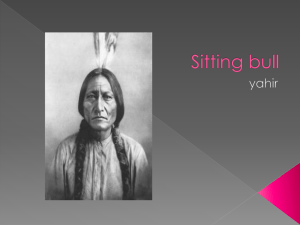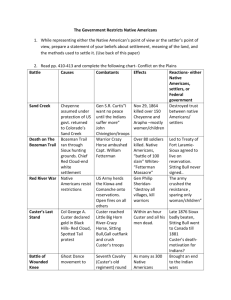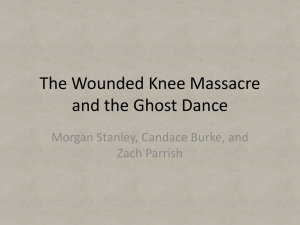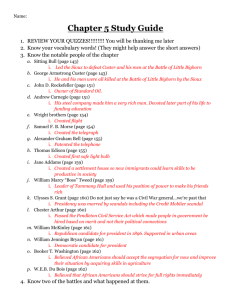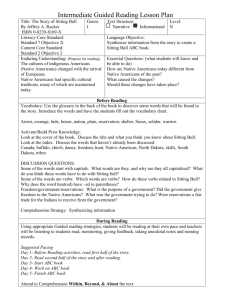Standard 11: Describe the growth of technogical innovations & big
advertisement
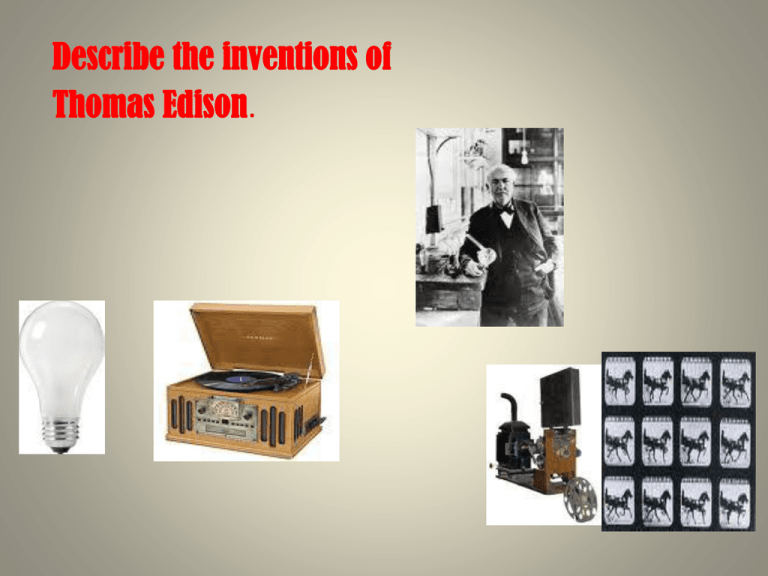
Describe the inventions of Thomas Edison. So you like to jam to your tunes? From Say thank you Thomas Edison!! to….. So you want to chill & kick with a movie? From Say thank you Thomas Edison!! to… So you like light? Just say thank you to Thomas Edison!! I. New Inventions (late 1800’s, early 1900’s) A. Light Bulb B. Phonograph (record player) C. Kinetoscope (Motion Picture) II. Railroads Impact on the Nation A. Encouraged new innovation 1. Refrigerated railcars (ice cream on a train!!) 2. Telegraph system (like texting old school train style) 3. Airbrakes (stops better, smoother, saves your life) B. Established time zones (We are EST…you are halfway through your day…your cali peeps are in homeroom saying the pledge!) C. Made travel between towns easier D. Transports large amounts of goods quickly & efficiently (means cheaper prices for you!! Also, Lincoln’s secret weapon for this reason). II. Railroads Impact on the Nation continued… E. Businesses could obtain raw materials & sell to large numbers of people F. Led to mass production (industrialization) G. Helped settle the west Railroad companies sold the fertile land cheaply Cattle ranchers and farmers used the plains to graze their herds and grow their crops, then used railroad to ship their products. III. Transcontinental Railroad Central Pacific Union Pacific Owned by Jay Gould Owned by Cornelius Vanderbilt Chinese Immigrant Irish Immigrants Sacramento, CA Omaha, NE Promontory Point, UT May 10, 1869 RESULTS of the Transcontinental Railroad 3 Part Library video series Industrialization and Urbanization video: https://www.youtube.com/watch?v=21bQiTxUar4 RESULTS of the Transcontinental Railroad – Transporting goods was easier – Linked new markets – Unified the nation Also led to Big Business & America’s Monopolies Gould & Vanderbilt were among a group of wealthy businessmen called ROBBER BARONS Goals of Robber Barons 1. Eliminate Competition 2. Create a monopoly ( just like the game…total control of an industry) The Triumph of Industry Life in 1865 Life in 1900 The Growth of Big Business Business Leaders of the Late 1800s • • • • • • • Robber Barons? Drained the country of its natural resources Persuaded officials to interpret laws in their favor Paid their workers meager wages Workers forced to work in dangerous and unhealthy conditions Swindled the poor Charged unfair prices Used Trusts & Monopolies to destroy other competitors • • • • • Captains of Industry? Increased the supply of goods by building factories Provided jobs that allowed Americans to buy their goods Founded and funded museums, libraries, and universities Innovations & businesses allowed the US economy to grow Philanthropy (giving $ to charity) Andrew Carnegie • Emigrated to the U.S. in 1848; used money earned as superintendent of PA railroad to invest in steel mills • Established Carnegie Steel Company, drove competitors out of business, and soon controlled the entire steel industry • Bought the iron ore mines, mills, shipping and rail lines to transport his steel products to market • Philanthropist: gave away $350 million • “Gospel of wealth”: free to make money and should give it away JP Morgan • Born to life of leisure • Worked to get European investors for business growth • Loaned money to US Government • Kept it all • Least amount of $$ of robber barons Cornelius Vanderbilt • Converted shipping empire to the new and upcoming railroad system • When he died at 84 yrs worth 100 Million • Left One million to Vanderbilt University • Remnants of railroad system now part of AMTRAK • Biltmore estate was his family’s “summer” home BILTMORE…SUMMER GET AWAY! The Standard Oil Trust I would rather earn 1% off a 100 people's efforts than 100% of my own efforts. John D. Rockefeller • Edwin L. Drake struck oil in Titusville, PA in 1858. • John D. Rockefeller set up a refinery in Ohio in • • • • 1863. He undersold his competitors and bought them out. In 1882 the owners of Standard Oil and other companies combined their operations, appointing nine trustees. Rockefeller controlled the trust Forty companies joined the trust and controlled the nations oil, limiting competition 1890 Congress passed the Sherman Antitrust Act, outlawing any combination of companies that restrained commerce; proved ineffective for 15 years. What Is Progress? What power do people have when the govt makes laws you don’t agree with? • Initiative-process in which citizens put a proposed new law directly on the ballot (U want a law….take the initiative & put it on the ballot!!) Ex. MADD (mothers against drunk driving) drunk driving laws, Hate Crime laws…public initiatives • Referendum-process in which citizens can approve or reject a law passed by a legislature (U don’t like a law your govt passed? You be the ref & decide!) Ex. Gay marriage in California, Legalizing marijuana in Cali (failed) • Recall-voters can remove elected officials from office (you don’t like your rep…recall their booty out of office) Ex. Governor Gray Davis in Cali got recalled & in the interim election …the terminator gets elected. V. Labor Force The Growing Work Force • 14 million immigrants between 1860 and 1900 • Contract Labor Act, 1864 • 8 to 9 million moved to the cities • Every family member worked; little relief for the poor Factory Work • • • • Boring, repetitive work in dangerous working conditions (low light, no ventilation, crowded) for low pay & long hours Piecework: fixed amount for each finished piece produced Frederick Winslow Taylor increased efficiency, The Principles of Scientific Management Division of Labor: workers performed one small task, over and over • Remember: Carnegie gave how many days off a year? How many hours a day? Families Working in the Factories….Working Women and Children • Women operated simple machines and had no chance to advance • Children made up more than 5 % of the labor force • Both Parents worked as well as children (stunted in body and mind) • Jacob Riis attacked child labor in Children of the Poor “The Great Strikes” Gulf Between Rich and Poor • Collective Bargaining: negotiating as a group for higher wages & better working conditions • Socialism: economic and political philosophy that favors public or social control of property and income, not private control Rise of Labor Unions • National Trades Union, 1834; ended with Panic of 1837 • National Labor Union, 1866; failed during a depression • Knights of Labor, 1869; men, women, skilled and unskilled; Terence Powderly wanted equal pay, 8 hour day, end to child labor; disappeared by 1890s • American Federation of Labor, 1886; Samuel Gompers wanted skilled workers only; supported collective bargaining, negotiation between labor and employers, wanted shorter hours & better pay…women & afams not included. • The Wobblies (Industrial Workers of the World), many Socialists, radical union of unskilled workers such as miners, lumbermen, migrant farm workers, textile workers Reaction of Employers • • 1. 2. 3. 4. 5. Feared unions Tactics to stop unions Forbade union meetings Fired union organizers “Yellow dog” contracts – promised never to join a union Refused collective bargaining Refused to recognize unions as workers’ representatives Strikes Rock the Nation • Haymarket Riot, 1886, at Chicago’s McCormick reaper factory; bomb killed seven policemen, gunfire killed dozens. Eight anarchists, radicals who oppose all government, were tried for conspiracy to commit murder. • Pullman, 1894, Eugene V. Debs called for a boycott of Pullman cars. Disrupted western railroad traffic. Federal troops sent to see that mail got through. Set pattern for the employers to get court orders against unions. EFFECT: Government opposition limited union gains for more than 30 years The Gilded Age 1 IMMIGRATION, AND URBAN LIFE THE GILDED AGE • The Period between 1877–1900 is known as “The Gilded Age” – Gilded means covered in a thin layer of gold – Term first used by American writer Mark Twain • During the Gilded Age, America‘s big businesses prospered • Beneath this layer of prosperity were the problems of poverty, discrimination and corruption POLITICS and ECONOMICS IN THE GILDED AGE • During the late 1800s, big business attempted to dominated American economics and politics – Laissez-Faire economics – Spoils system/patronage-based politics The Way We Were in The Gilded Age: 1877-1901 Who We Were How We Lived 1880 1890 1900 1880 1890 1900 Population (millions) 50.2 63.0 76.0 Gallon of milk $0.16 $0.17 $0.30 Pop. per sq. mile 16.9 21.2 25.6 Loaf of bread $0.02 $0.02 $0.03 Percent rural 71.8 % 64.9 % 60.4% New auto N/A N/A $500 Percent urban 28.2 % 35.1 % 39.6% Gallon of gas N/A N/A $0.05 Percent native born 94.4 % 87.1 % 84.4% New house $4,50 0 $5,80 0 $4,00 0 Percent immigrant 5.6% 12.9 % 15.6% Average income $480 $660 $637 PEOPLE ON THE MOVE!!! •During the late 1800s and early 1900s, immigrants from around the world came to the United States in search of a Northern and Central Europe better life. 56% Southern and Eastern Europe 32% The Americas 9% Asia 2 % Oceania .2% Africa .1% Immigration to the United States by Region, 1871–1920 Old Immigrants New Immigrants Place of Origin Northern & Western Europe (England & Scandinavia) Southern & Eastern Europe (Italy, Spain), Asia Language English Native Tongue Religion Protestant Roman Catholic Race White White, Yellow Where they settled East Coast, 13 colonies 50% in cities (Boston, NY, Chicago, Philadelphia) Integration Melting Pot (blended together) Salad Bowl (separate) The Immigrant Experience • Most immigrants still came from Europe • Crossed the Atlantic Ocean and arrived in New York- The Golden Door – 1-3 weeks on a ship – Most traveled in steerage • Crowded lower berths • Think Leo in Titanic! – Almost 70% arrived through New York – Most settled with others of same ethnicity • Neighborhoods of ethnic groups developed in Boston, New York, Philadelphia… Why were the immigrants resented? 1. They work for lower pay during strikes 2. They lived in cities and were highly visible. • The Immigrant Experience Path of acceptance was more difficult for Asians – Most arrived in San Francisco, Angel Island – The Golden Gate • After the gold rush, Chinese immigrants worked as agricultural laborers, on railroad construction crews throughout the West, and in low-paying industrial jobs. – Chinese Exclusion Act 1882 • This Act virtually ended Chinese immigration for nearly a century – Asian Segregation of Asian children in schools in 1906 • Japanese complained of mistreatment • “The Gentlemen’s Agreement” was passed in 1907 ending segregation • The Chinese Question • Harper’s Weekly REACTIONS TO IMMIGRANTS Nativists Try to restrict immigration, believe government should support nativeborn Americans over immigrants Temperance Movement/ Purity Crusaders Settlement Movement Try to ban alcohol, drugs, gambling, and prostitution Try to help immigrants improve their lives by offering education, child care, and health care THE CHALLENGE OF THE CITIES • The arrival of millions of new residents brought progress, poverty, and political changes to American cities. State Street, Chicago, 1905 • How Cities Grew Suburbs – residential communities – People that could afford it moved out and took horse drawn carriages in • Motorized Transportation – Subways, trolley cars, elevated trains (El), automobile • Growing Upward – Skyscrapers – Chicago’s Home Insurance Company building was the first 10 story building From Farms to Cities • Women were needed less • New Machines replaced laborers • 1880-1910 population on farms fell from 72 to 54 percent • African Americans migrated north New York by George Bellows Urban Living Conditions • Tenements – Speculators built tenements and packed many people in them – Created slums – Go to : http://www.history.com/videos/deadrabbit-gang-battles-bowery-boys – Slum Conditions – Poverty, overcrowding, neglect, fire danger • Ghettos – Slums where one ethnic or racial group dominated – Restrictive covenants – don’t let certain people buy land • Jacob Riis – worked to improve the lives of the urban poor – NY passed first laws to improve tenements b/c of Riis The Results of City Growth Rise of Political Bosses • Political Machine – Unofficial city organization designed to keep a particular party in power – Usually headed by a powerful “boss” – “Boss” would handpick candidates for local office in return for economic favors – Supported by immigrants and poor people – Graft – using one’s job to gain profits • William “Boss” Tweed – Controlled Tammany Hall in New York – Ran New York’s Democratic Party Ideas for Reform The desire to improve conditions in American cities led to the formation of new reform groups Charity Organization Movement Making charity scientific (like welfare system) Kept details of who received help so that they knew who was worthy of help or not Many expected immigrant to adopt American middle class standards of living The Social Gospel movement Applied religious principles of charity and justice for the poor Supported labor reforms and improved living conditions Settlement Movement (Jane Addams/Ellen Gates Starr) Created “settlement houses” to offer social services and to help the poor, HULL HOUSE African-Americans in the Progressive Era • Plessy vs. Ferguson- Separate, but equal is legal. • NAACP: National Association for the Advancement of Colored People • Purpose: To ensure economic, social, political and educational equality for minority groups in America. • Go through the legal system (courts) to make change "My lands are where my dead lie buried" -Crazy Horse "I wish it to be remembered that I was the last man of my tribe to surrender my rifle." -Sitting Bull “Hurrah, boys! We've got them!” - General George Custer at the Battle of Little Big Horn Land for Sale!! Pacific Railway Acts of 1862 and 1864 gave the Union Pacific and Central Pacific railroad companies 10 square miles on each side of the tracks. They sold land to settlers who wanted farms Very profitable for railroads AND the lucky few who got this land Geronimo • Famous Apache warrior – Was born in 1829 in what today is New Mexico • One of the most pivotal moments in Geronimo's life was in 1858 when he returned home from a trading excursion into Mexico. – He found his wife, his mother and his three young children murdered by Spanish troops from Mexico. – This reportedly caused him to have such a hatred of the whites that he vowed to kill as many as he could. • From that day on he took every opportunity he could to terrorize Mexican settlements and soon after this incident he received his “power”, which supposedly came to him in visions • After the area was claimed by the US, Geronimo led a band of Apache against these “outsiders” in 1865 Rage Among the Apache, Cheyenne, Sioux, and Navahos • Geronimo and the Navajo and Apache wars continued until Geronimo surrendered in 1886 • The Cheyenne were attacked by the US army at Sand Creek in Colorado, with as many as 450 dead. • The First Sioux War in 1865 occurred when the government decided to build a road through Sioux lands – That ended when the Sioux agreed to return to their reservation Face-Off Between the Cultures • The Second Sioux War began in 1875 when miners went to the Black Hills in South Dakota and Chief Sitting Bull left the reservation again – The American Army was called in to bring him back…they called on General George Custer for the job The Black Hills of North Dakota Chief Sitting Bull •Sitting Bull was born around 1831 on the Grand River in present-day South Dakota •Sitting Bull was given the name Tatanka-Iyotanka, which describes a buffalo bull sitting intractably on its haunches. • It was a name he would live up to throughout his life. Chief Sitting Bull • Sitting Bull's courage was legendary. • Once, in 1872, during a battle with soldiers protecting railroad workers on the Yellowstone River, Sitting Bull led four other warriors out between the lines, sat calmly sharing a pipe with them as bullets buzzed around. • He carefully reamed the pipe out when they were finished, and then casually walked away. The 2 Leaders Meet • In the summer of 1876 Custer was sent from Fort Abraham Lincoln to capture Sitting Bull and his band of Sioux • On the verge of what seemed to him a certain and glorious victory for both the United States and himself, Custer ordered an immediate attack on a Sioux village. Custer’s Last Stand • The attack was one the greatest fiascos of the United States Army. • Thousands of Lakota, Cheyenne and Arapaho warriors forced Custer's unit back onto a long, dusty ridge parallel to the Little Bighorn, surrounded the soldiers and killed all 200+ American soldiers. The Battlefield Today Paintings of Little Big Horn usually depict Custer as a gallant victim, surrounded by bloodthirsty savages intent upon his annihilation. They Won the Battle, but Lost their Culture • Usually forgotten was the other side of the story, and that most of Indians present were forced to surrender within a year of their greatest battlefield triumph. Sitting Bull is finally Captured • Sitting Bull thought by winning this battle, the U.S. government would leave him alone, but the fight had just begun. • As the battles continued, many of Sitting Bull's followers surrendered. – However, Sitting Bull did not give up. • In 1877, Sitting Bull and his followers escaped into Canada. • However within four years, famine forced them to surrender. Sitting Bull’s Later Years • Sitting Bull was held as a prisoner of war for two years. • In 1885, Sitting Bull joined Buffalo Bill's Wild West Show and traveled throughout the United States and Canada. The Fate of Indian Territory • Nearly 70 Indian nations had been forced onto Indian Reservations • The Native American cultures were shattered – Farming tribes were left with no land to farm – Herding tribes were left with no land to herd – The result was heartbreaking as these tribes were forced to integrate on strange lands with little resources • In 1889 Congress opened the confiscated 2 million acres to settlers • Some Indian leaders led rebellions to no avail The Ghost Dance • When Sitting Bull returned to the reservation in 1889, many natives had joined a new religion called the Ghost Dance. • They believed an Indian messiah would return their lands and remove the whites. Massacre at Wounded Knee • White officials became alarmed at the religious fervor and activism and in December 1890 banned the Ghost Dance on Lakota reservations. • When the rites continued, officials called in troops to the reservations in South Dakota. • The resulting massacre, which lasted less than an hour, found at least 150 Indians had been killed and 50 wounded. • In comparison, army casualties were 25 killed and 39 wounded. Dawes Act • In February 1887, Henry Dawes persuaded Congress to pass legislation that became known as the Dawes Plan. – The plan said that Native Americans should be granted land in exchange for renouncing tribal allegiances. • Under the terms of this legislation all family heads received one hundred acres, and each dependent child 40 acres. – This land was held in trust for 25 years, at the end of which time the holder was to acquire full title with the right to sell. • That Native Americans who received this land were also granted citizenship and full political rights. Results of Dawes Act • The Dawes Act was disastrous for most Native Americans. – The Act forced Native people onto small tracts of land distant from their kin relations. – The allotment policy depleted the land base, ending hunting as a means of subsistence. – Traditionally women were the agriculturists while the men were the hunters and warriors. • Far from making them self-reliant farmers, it shattered one of the main pillars of their culture-community property. • Besides the loss of identity, most lost their livelihoods when they could not make the transition to individualized, self-sufficient agricultural farming. The Death of Sitting Bull • Because of this new religion, Indian police arrested Sitting Bull on December 15, 1890 as a precaution. • They planned to send Sitting Bull to prison, but when his warriors attempted to rescue him, he was killed. • He was buried at Fort Yates. • In 1953, his remains were moved to Mobridge, South Dakota. Crazy Horse • Crazy Horse was a legendary Lakota (Sioux) warrior • Even as a young man, he stole horses from the Crow Indians before he was thirteen, and led his first war party before turning twenty • Crazy Horse earned his reputation not only by his skill and daring in battle but also by his fierce determination to preserve his people's traditional way of life. • There are no pictures of Crazy Horse…he never allowed it. The Death of Crazy Horse • He was killed on September 6 under strange circumstances at Fort Robinson, Nebraska. • He fought his entire life for the preservation of the land and culture of the Sioux Indians. South Dakota… Home to Two Monuments ?? Crazy Horse Monument • The Crazy Horse Memorial is a memorial to the famous Native American leader • The form is of a huge statue of the rider on horseback carved from the side of a mountain. http://www.crazyhorse.org/ Chief Joseph and the Nez Perce • The Nez Perce tribe was located in what is today Oregon and Washington • When young members of the tribe attacked white settlers, the settlers vowed to get revenge • They fled, but were attacked by US troops at Big Hole Basin – Men, women, and children were killed • Chief Joseph tried to escape with his people and got to within 40 miles of Canada when he was captured – “I am tired of fighting” • Finally settled on a reservation in Washington State Native Cultures Destroyed • • • • Most leaders dead or under arrest Buffalo killed off Native Americans are forbidden to practice their religions The abuse of the Dawes Act resulted in the loss of much of their lands • The amount of land owned by Indians shrank by 65% by 1934.
